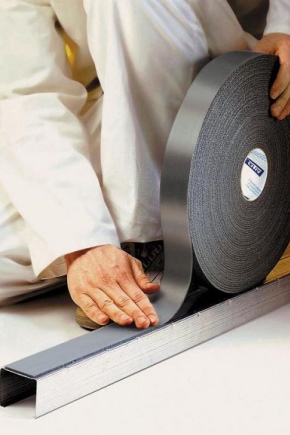Features of damper tape for drywall profile

It is absolutely necessary for every builder, repairman and home owner to know the features of a damper tape for a drywall profile. It is worth carefully examining the sealing self-adhesive elastic tape for the guides, for soundproofing needs. It is required to investigate its installation, to deal with the damping and vibration damping tapes.

Advantages and disadvantages
Damper tape for metal plasterboard profiles is used quite often. Plasterboard sheets are used very widely, this is a massive type of finishing material. In terms of aesthetic and practical properties, they are very good, including for partitions, but there is one serious problem. Although it is said that the gypsum board absorbs extraneous sounds, its soundproofing capacity is not too great. And the metal profile only enhances this danger.
Therefore, the need to use special protection arises in any case. Professionals never tire of reminding that soundproofing tape in conjunction with a profile is the best possible solution. Elastic raw materials and special glue are used to obtain the tape material. High-quality self-adhesive products can be mounted without unnecessary problems on any surface.
Installation time is relatively short.


The modern sealing tape is really effective at dampening sound. It does not absorb water, therefore, a negative effect on the surface of the drywall sheet is excluded. Elastic damping products weigh relatively little and therefore do not have a significant effect on the operation process. High-quality polyethylene perfectly resists defeat:
- alkalis;
- acids;
- various types of fungal organisms.
Of course, such a product is capable of surviving significant temperature fluctuations. Responsible manufacturers care about maximum environmental friendliness and a long period of work, even in difficult conditions.
Vibration damping tape for a drywall guide - as its name implies - eliminates not only extraneous sounds, but also vibrational vibrations.



It is also able to extinguish pronounced surface roughness, which greatly simplifies installation in a number of cases. Supports joint protection, seam sealing. The damper tape has no noticeable drawbacks.

Manufacturers
The Knauf-Dichtungsband sealing tape is popular. It is an elastic product with small pores and closed cells. Crosslinked polyethylene foam is chosen as the raw material. It is worth noting that the same product is also applicable for the partition profile, and for the floor and ceiling guides. Width varies from 30 to 95 mm, thickness is always 2-5 mm.
Sealing tape of this brand can have one more application - as thermal insulation. It is used as such for:
- air ducts;
- other pipelines;
- openings of windows and doors.


Technological parameters:
- white or gray color;
- density - from 30 to 36 kg per 1 m3;
- roll length 15, 20 or 30 m;
- excellent resistance to gasoline and alcohol, crude oil and industrial oils;
- water absorption index - 0.1%;
- total hygienic safety;
- lack of toxicity, odors and allergic reactions.
Alternative - "Tilit Super". Foamed polyethylene is used for the manufacture of such a tape. The gray product is covered with an insulating apron on one side.
You can also use the insulating tape "SK Trading". Its dimensions are 50 mm by 30 m. Another option is the Soundguard Band.



Mounting
Damping tape on a paper basis is used subject to mixing a certain volume of putty mixture... Such a mass is required to be positioned along the border of the sheet. It must be laid out with a push. Then the tape is placed as neatly as possible, just along the seam. The last step is to hold the spatula with light pressure along the entire length.
Excess solution is carefully removed. When all this is dry, you need to use another layer of putty. The surface is leveled again, and then the entire plane is rubbed. Further:
- the surface is thoroughly cleaned so that there is no moisture and dust on it;
- the adhesive reversal of the tape is attached to the guide profile or its segment;
- apply the tape to the desired wall surface;
- ensure its attachment by lightly pressing;
- fix the profile to the substrate with special dowels.

Installation of the seal is carried out at a temperature of at least +5 degrees. If it is more than +40 degrees, the tape cannot be mounted either. During work, you should:
- control air humidity;
- exclude the slightest drafts;
- check the strength of the original plasterboard structure - if the reliability is insufficient, the damper will not help;
- if possible, use wide variations of tape to eliminate serious cracks and to form large borders.














The comment was sent successfully.